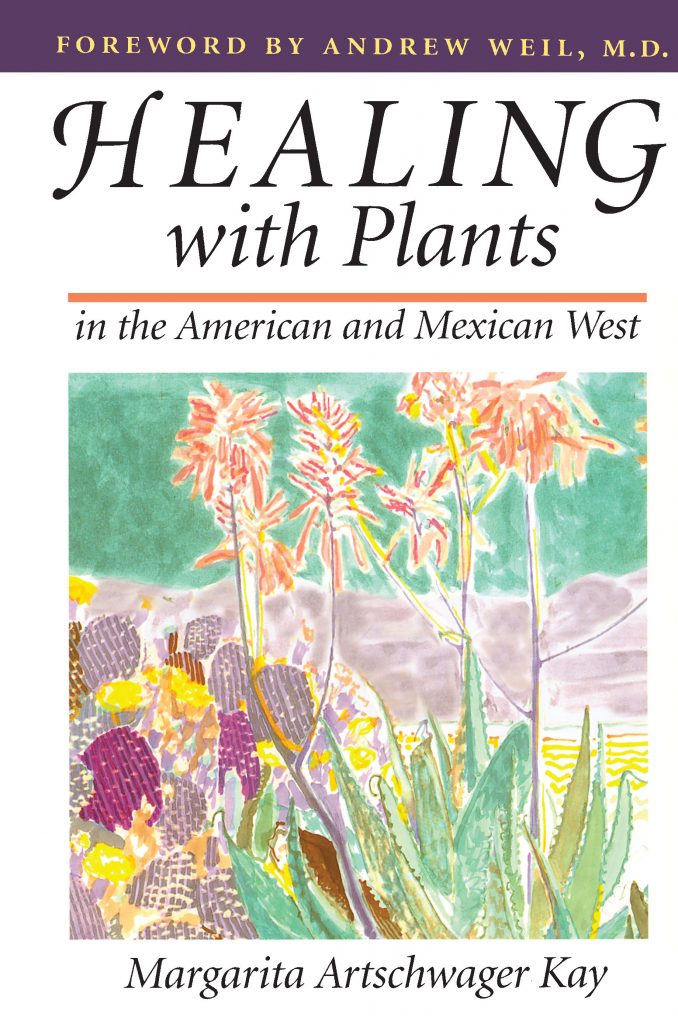Healing with Plants in the American and Mexican West
Paperback ($32.00), Ebook ($26.95)
Buy
Disenchanted with biomedicine and dismayed by its cost, increasing numbers of people are seeking alternative therapies such as the healing plants discussed in this book. Plant medicine is a billion-dollar business: health food stores, small yerberias, and even giant grocery store chains carry hundreds of medicinal herbs. By one estimate, up to one-third of the U.S. population uses alternative medicine—generally in addition to conventional therapy and commonly without telling their doctors. The heart of this volume is a complete description of 100 plants commonly used today, often for the same purposes reported by chroniclers of the Aztecs or eighteenth-century European explorers. Information for each plant includes botanical and common plant names, history, contemporary uses, a description of how the plant is prepared and administered, and brief phytochemical data. Discussions of folk efficacy and folk properties—beliefs in how and why the herb heals—help to explain the continued use of each plant into the present day. Are any of these plants dangerous, and do any of them really work? Where did they come from, and where are they available now? How can health-care practitioners gain the confidence of their patients to learn whether they are using alternative medicines for specific illnesses, symptoms, or injuries? Perhaps most intriguing, which of these plants might be waiting to take the place of known antibiotics as pathological organisms become increasingly resistant to modern miracle drugs? Answers to these and other questions will pique the interest of general readers and will be an invaluable resource for health-care providers—especially nurses and other primary-care providers, who often must find an interface between biomedical and more traditional therapies. For all readers, the book opens a window into many ethnic cultures of the region—Mexican American communities, desert Pima, coastal Seri, and others. Here is the fascinating saga of how their healing plants from prehistoric times melded with Old World herbs brought by the Europeans to create the unique pharmacopoeia available today here and in other parts of the world. Plants included:
Acacia (Cassie, Acacia)
Achillea (Yarrow)
Agastache (Giant Hyssop)
Agave (Century Plant)
Allium (Garlic, Onion)
Aloe (Aloe)
Ambrosia (Ragweed)
Anemopsis (Yerba Mansa)
Arctostaphylos (Bearberry, Uva Ursi)
Argemone (Prickly Poppy)
Aristolochia (Bithwort, Snakeroot)
Arracacia (Arracacha)
Artemisia (Wormwood, Mugwort, Western Mugwort, Sagebrush)
Asclepias (Milkweed)
Baccharis (Desert Broom, Seep Willow)
Bocconia (Tree Celandine)
Buddleia (Butterfly Bush)
Bursera (Elephant Tree)
Caesalpinia (Mexican Bird-of-Paradise)
Cannabis (Marijuana)
Capsicum (Chili)
Carnegiea (Saguaro)
Casimiroa (Zapote)
Cassia (Senna)
Cereus (Cactus)
Chenopodium (Goosefoot, Wormseed)
Citrus (Lemon, Lime, Orange)
Datura (Jimson Weed)
Ephedra (Mormon Tea)
Equisetum (Horsetail)
Eryngium (Eryngo, Button Snakeroot)
Eucalyptus (Eucalyptus)
Euphorbia (Spurge)
Eysenhardtia (Kidneywood)
Gnaphalium (Everlasting, Cudweed)
Guaiacum (Lignum Vitae)
Guazuma (Guazuma)
Gutierrezia (Turpentine Bush)
Haematoxylon (Logwood)
Haplopappus (Jimmyweed)
Heterotheca (Telegraph Plant, Falso Arnica)
Hintonia (Copalqu¡n)
Ibervillea (Coyote Melon)
Jacquinia (Jacquinia)
Jatropha (Limberbush)
Juniperus (Juniper)
Karwinskia (Coffeeberry)
Kohleria (Tree Gloxinia)
Krameria (Ratany)
Lantana (Lantana)
Larrea (Creosote Bush, Greasewood)
Ligusticum (Lovage)
Lippia (Oregano)
Lysiloma (Featherbush)
Malva (Mallow)
Mammillaria (Pincushion Cactus)
Mascagnia (Mascagnia)
Matricaria (Chamomile)
Mentha (Mint)
Nicotiana (Tobacco)
Ocimum (Basil)
Opuntia (Cholla, Prickly Pear)
Perezia (Perezia)
Persea (Avocado)
Phaseolus (Bean)
Phoradendron, Stru
Acacia (Cassie, Acacia)
Achillea (Yarrow)
Agastache (Giant Hyssop)
Agave (Century Plant)
Allium (Garlic, Onion)
Aloe (Aloe)
Ambrosia (Ragweed)
Anemopsis (Yerba Mansa)
Arctostaphylos (Bearberry, Uva Ursi)
Argemone (Prickly Poppy)
Aristolochia (Bithwort, Snakeroot)
Arracacia (Arracacha)
Artemisia (Wormwood, Mugwort, Western Mugwort, Sagebrush)
Asclepias (Milkweed)
Baccharis (Desert Broom, Seep Willow)
Bocconia (Tree Celandine)
Buddleia (Butterfly Bush)
Bursera (Elephant Tree)
Caesalpinia (Mexican Bird-of-Paradise)
Cannabis (Marijuana)
Capsicum (Chili)
Carnegiea (Saguaro)
Casimiroa (Zapote)
Cassia (Senna)
Cereus (Cactus)
Chenopodium (Goosefoot, Wormseed)
Citrus (Lemon, Lime, Orange)
Datura (Jimson Weed)
Ephedra (Mormon Tea)
Equisetum (Horsetail)
Eryngium (Eryngo, Button Snakeroot)
Eucalyptus (Eucalyptus)
Euphorbia (Spurge)
Eysenhardtia (Kidneywood)
Gnaphalium (Everlasting, Cudweed)
Guaiacum (Lignum Vitae)
Guazuma (Guazuma)
Gutierrezia (Turpentine Bush)
Haematoxylon (Logwood)
Haplopappus (Jimmyweed)
Heterotheca (Telegraph Plant, Falso Arnica)
Hintonia (Copalqu¡n)
Ibervillea (Coyote Melon)
Jacquinia (Jacquinia)
Jatropha (Limberbush)
Juniperus (Juniper)
Karwinskia (Coffeeberry)
Kohleria (Tree Gloxinia)
Krameria (Ratany)
Lantana (Lantana)
Larrea (Creosote Bush, Greasewood)
Ligusticum (Lovage)
Lippia (Oregano)
Lysiloma (Featherbush)
Malva (Mallow)
Mammillaria (Pincushion Cactus)
Mascagnia (Mascagnia)
Matricaria (Chamomile)
Mentha (Mint)
Nicotiana (Tobacco)
Ocimum (Basil)
Opuntia (Cholla, Prickly Pear)
Perezia (Perezia)
Persea (Avocado)
Phaseolus (Bean)
Phoradendron, Stru
"Superbly well-organized and well-written." —Western Historical Quarterly"A work of scholarship and a fascinating read." —Western Journal of Nursing Research"This work has broad, general appeal and illuminates many ethnic cultures. I should find a wide reading audience." —Come-All-Ye"Extremely well researched, and full of fascination to the 'medical cultural brokers' Kay sees as her major audience." —NAHUA Newsletter"Dr. Kay has done an admirable job in providing researchers and the general public with a book that will not only substantiate the use of many traditional remedies of the Southwest and Northern Mexico, but will also offer a springboard to research on the potential value of incoroporating some of these remedies into modern self-care and health care. . . . It will no doubt become a classic work and an oft-cited reference in this increasingly important subject" —Herbalgram
 The University of Arizona Press
The University of Arizona Press

